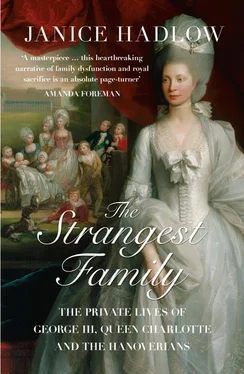Yet for all Lady Sarah’s careful preparation, she could not get near the king, and nothing came of it. Then, at the end of June 1761, the king made yet another of his cryptically encouraging remarks, this time to Sarah’s sister Emily, telling her: ‘For God’s sake, remember what I said to Lady Susan … and believe that I have the strongest attachment.’ A few days later, Fox was dumbstruck to be told that the meeting of the Privy Council summoned for 8 July was ‘to declare His Majesty’s intention to marry a Princess of Mecklenburg!’ 131
No one could believe it, least of all Sarah. On the day after the meeting – and its purpose – had been announced, ‘the hypocrite had the face to come up and speak to me with all the good humour in the world, and seemed to want to speak to me but was afraid. There is something so astonishing in all this that I can hardly believe …’ 132For months, Lady Sarah and Fox puzzled and obsessed over what the strange and confusing episode had meant. Lady Sarah could not help but feel humiliated, but was determined not to let others see it. ‘Luckily for me, I did not love him, and only liked him, nor did the title weigh anything with me; or so little at least, that my disappointment did not affect my spirits above one hour or two, I believe.’ 133If that was an exaggeration born of bravado, it was nonetheless true that she had recovered her spirits sufficiently to accept without a qualm the invitation to act as one of the bridesmaids at George’s wedding a few months later. ‘Well, Sal,’ sighed Fox, making his own final comment on the whole affair, ‘you are the first virgin’ – or as he jokingly pronounced it, ‘the first vargin ’ – ‘in England, and you shall take your place in spite of them all, and the king shall behold your pretty face and weep.’ 134
Had either Fox or Lady Sarah asked George to explain his behaviour, it is hard to know what he might have said. No one could deny that his conduct had not been strictly honourable. Although he had not made a direct proposal of marriage, he had come pretty close to it, and he had certainly encouraged Sarah to think of him as some kind of suitor when he was not, as he knew only too well, in a position to offer any respectable outcome to their developing relationship. By January 1761, preliminary enquiries had begun in Germany to find him a woman he could marry, but, despite all his assurances to Bute and to himself, he was still irresistibly drawn to Sarah Lennox, dropping suggestions and making promises that he knew he could not keep. When, in the spring, he made his fateful declaration to Lady Susan Fox-Strangways, he was privately reading reports evaluating the looks and characters of every German Protestant princess of marriageable age. His formal proposal to the Princess of Mecklenburg was accepted on 17 June, only days before he made yet another of his insistent speeches to Sarah’s sister Emily, beseeching her to ‘believe that I have the strongest attachment’.
George’s motives, in the end, remain opaque; but perhaps he explained his actions to himself by considering them as the contradictory product of the two conflicting aspects of his identity. The king in him submitted, as he knew he must, to an arranged marriage with a woman he had never seen; but the ‘boiling youth of 21 years’ found it harder to accept that he ‘must often act contrary to my passions’, and that to ‘the interest of my country … my own inclinations shall ever submit’. In 1760–61, for the first and only time in his life, George allowed his heart to rule his head and followed the call of instinct, not obligation. He knew from the beginning which way it would end, recognising that he was formed for duty not rebellion. However, before the world of you shall closed inevitably and finally over the prospect of you could , he enjoyed a brief flirtation with the alternative. While he kept his sanity, he would never stray again.
DEATH HAD COME SUDDENLY UPON George II, with very little regard for his dignity. Horace Walpole heard that the last day of the king’s life had been conducted with the same punctiliousness which had marked all his actions. At six in the morning he had been served his breakfast chocolate. ‘At seven, for everything with him was exact and periodic, he went to his closet to dismiss it.’ When he did not emerge from his private lavatory, his valet, Schroeder, grew alarmed. Drawing closer to the door, he ‘heard something like a groan. He ran in, and found the king on the floor.’ He had cut the right side of his face as he collapsed. Schroeder may have been the author of the laconic coded note hurriedly sent to the young Prince of Wales informing him what had happened to his grandfather. The stricken king did not respond to his valet, nor to the anxious ministrations of his servants, who carried him back to the more decorous surroundings of his bedroom. By the time they had summoned his spinster daughter Amelia, he was beyond help. Amelia’s sight was very poor, and when she saw her father laid on his bed she did not realise he was already dead. Walpole was told that ‘they had not closed his eyes’. Amelia bent down, ‘close to his face and concluded he spoke to her, though she could not hear him – guess what a shock when she found out the truth’. 1
George II was the first reigning monarch to have died in England for nearly fifty years. His funeral was intended to be an event both sombre and imposing, reflecting the dignity of the office of kingship and the mourning of a bereaved nation. It was held at night, and began with suitable solemnity, accompanied by muffled drum rolls and bells tolling in the darkness. Walpole, who could never resist the lure of a ceremony, was present throughout the proceedings. He thought the early stages were very impressive, and was moved, despite himself, by the severe choreography that marked the coffin’s journey to Westminster Abbey. But once inside the chapel, he was sorry to see that discipline and decorum fell apart: ‘No order was observed; people sat or stood where they could or would; the yeoman of the guard were crying out for help, oppressed by the immense weight of the coffin; the bishop read sadly, and blundered in the prayers.’ The dead king, with his obsessive devotion to the niceties of correct behaviour, would have been appalled. Walpole noticed that only the Duke of Cumberland – the chief mourner and the son George II had loved above all his other children – behaved as his father would have wished. ‘His leg extremely bad, yet forced to stand upon it nearly two hours; his face bloated and distorted by his late paralytic stroke … Yet he bore it all with firm and unaffected countenance.’
The same could not be said for the Duke of Newcastle, who had served as the late king’s first minister, and whose grief was flamboyantly unconstrained. ‘He fell back into a fit of crying the moment he came into the chapel, and flung himself back in his stall, the Archbishop hovering over him with a smelling-bottle.’ The sardonic Walpole noticed that Newcastle’s distress did not prevent him from surreptitiously making himself as comfortable as he could in cold and clammy circumstances. When Cumberland tried to shift his position, ‘feeling himself weighed down, and turning round, he found it was the Duke of Newcastle standing on his train to avoid the chill of the marble’. 2
For all the incipient disorder that so often overwhelmed even the most sober eighteenth-century spectacles, the final act of the funeral was a moment of genuine pathos. The king had always intended that he would be buried alongside his long-dead wife. Now, as his remains were placed in the grave next to hers, it was apparent that their two coffins had been constructed without sides, so that their bones would eventually mingle. Twenty-three years after her death, George and Caroline were united once more.
Читать дальше












